Do You Really Need to Prune Tomato Plants? Why You Should, According to an Expert
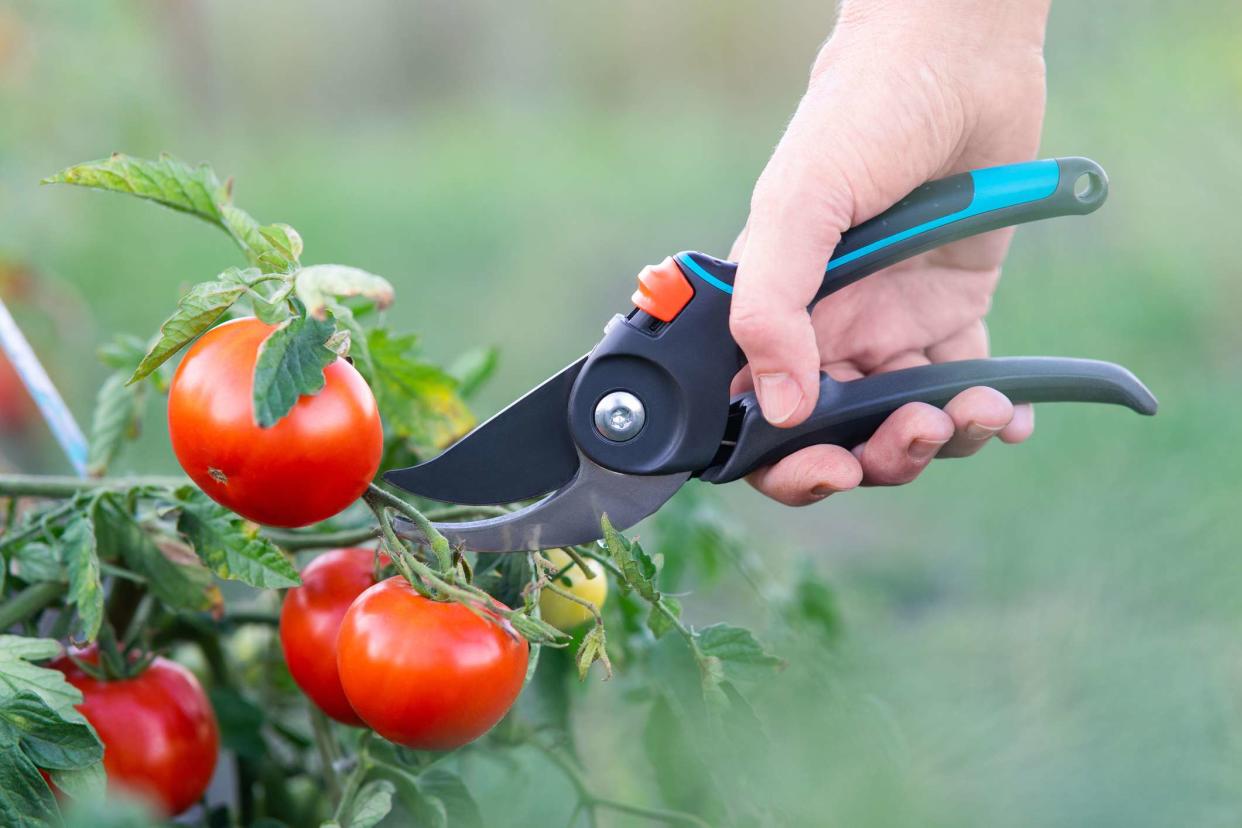
spb2015 / The Spruce
Tomatoes have earned a reputation for being one of the easiest veggies to grow, and while they certainly are easier than others (we're looking at you, eggplant) they’re not exactly hands-off.
Giving them the attention they need is key to keeping them happy and healthy all summer long, and one key task is pruning.
Pruning is snipping extraneous branches off the tomato plant, which allows it to focus on growing upwards, not out, since the bottom branches don't bear fruit. This is the best way to produce healthy, delicious-tasting fruit, though this important task is often overlooked.
How should you know if pruning is right for you? We turned to a few key experts for tips, tricks, and advice on tomato-plant pruning.
Why Do People Skip Pruning?
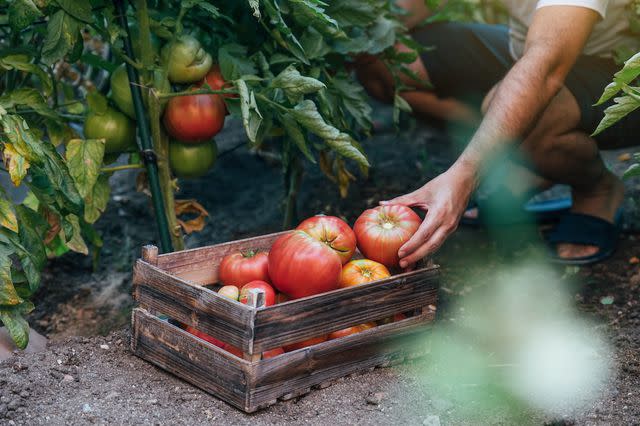
Cris Cantón / Getty Images
While some home gardeners might avoid pruning out of time constraints or simple forgetfulness, Nikhil Arora of Back to the Roots says others just aren’t aware of how important it is.
“There’s a lack of knowledge about its benefits, time constraints, or misconceptions about its necessity or potential harm to the plant,” he says.
Want more gardening tips? Sign up for our free gardening newsletter for our best-growing tips, troubleshooting hacks, and more!
Why You Should Prune Tomato Plants
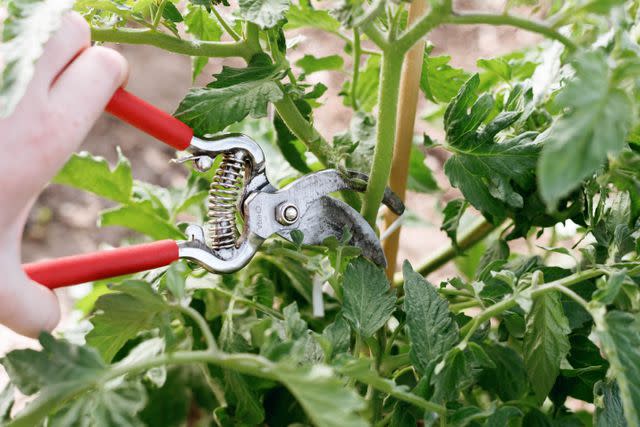
The Spruce / Michele Lee
As Arora explains, pruning your tomato plants offers a whole host of benefits that you might not realize—and all of it leads to a better, more productive plant.
Along with improving air circulation and reducing the risk of fungal diseases like blight, Arora says pruning enhances fruit quality by redirecting your plant's energy into production.
“This results in larger, healthier tomatoes, and facilitates plant management by controlling size and shape for easier support and harvest,” he says.
Donna Letier of Gardenuity agrees, noting that pruning allows more light to reach critical parts of your plant.
“Pruning will direct energy toward creating and ripening fruit instead of making more leaves,” she says.
Know Your Variety
Before you get out the shears, confirm your variety of tomato plant. All tomatoes are either determinate (bush tomatoes) or indeterminate (vine tomatoes), which affects their need for pruning.
Determinate varieties have a predetermined growth pattern, meaning they do not require extensive pruning other than removing yellow or diseased leaves.
On the other hand, indeterminate varieties call for more pruning to manage their vigorous growth.
How to Prune Tomato Plants
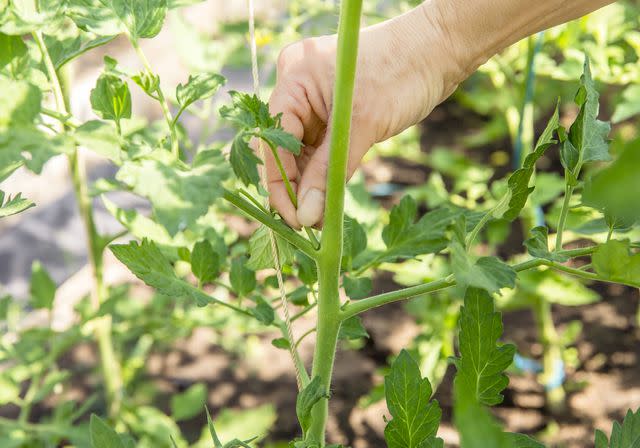
Helin Loik-Tomson / Getty Images
Pruning isn't quite as easy as snipping off a few dead leaves and tugging off your tomatoes as soon as they’re ripe. With the help of our experts, we’ve determined the key steps.
Assemble your supplies and ensure your scissors or shears are sharp and clean. A good pair of gardening gloves and a pair of sharp shears are a must for me when pruning, says Cullen Boudreaux of American Meadows. Wearing gloves helps prevent any mishaps that could happen.
Pick the right time of day. “I make sure to prune on dry days, as wet foliage can easily spread disease, and I often do my tomato gardening in the morning to avoid the full heat and sun of the day,” Boudreaux says.
Start from the bottom. Prune any branches off the bottom of the tomato plant touching the soil. For determinate varieties, remove yellow or diseased leaves only.
For indeterminate varieties, locate and prune the suckers. Suckers grow in the V space between the main stem and the branches on your tomato plant, according to Letier. Suckers under a few inches can be pinched off with your fingers, but for larger suckers, use a pair of clean pruners.
Start pruning after your plant forms its first flowers. Boudreaux removes extra suckers, leaving one or two main stems to produce fruit. Regularly pinch new suckers to direct the plant’s energy back to fruit production.
Prune for maintenance throughout the season. Remove any wilting, yellowing, or diseased leaves—lower leaves are older and can be removed to improve airflow and prevent disease.
Target shady areas as needed. Boudreaux also sometimes removes leaves that are shading fruit clusters, allowing sunlight to reach and ripen them.
Don’t over-prune. Never remove more than a third of a plant’s foliage once, says Boudreaux. Make sure you can tell the difference between the growing shoot of the tomato, located at the end or top of a stem, and the suckers you want to remove. Suckers are secondary shoots that grow from the junction between a leaf and the stem.
Top Tomato Care Tips
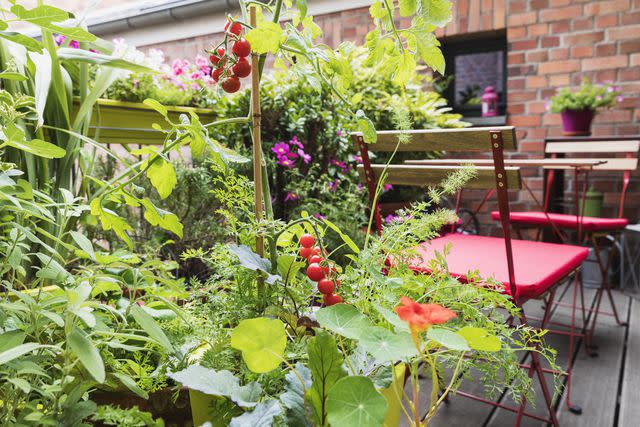
Westend61 / Getty Images
While indeterminate and determinate varieties have different needs, Boudreaux says there are a few key things that can be applied to all tomato plants.
Tomatoes love warmth and sunshine. They thrive in summer temperatures between 65 and 90 degrees and need 6-8 hours of full sun per day.
Tomato plants are sensitive to moisture. Keeping tomatoes consistently moist, but not wet, is key. Soil should feel like a wrung-out sponge and allowed to drain between waterings.
Container-grown tomatoes require more watering. All tomatoes will rapidly show wilt when they are too dry, so it's especially important to keep an eye on your container plants.
Nutrient-rich soil is a must. Tomatoes are heavy feeders—if you start with healthy, fertile soil you are already ahead of the curve.
Fertilize early. Applications of a balanced fertilizer early in the season will promote strong vegetal growth. Later in the season, a shift to a high phosphorous fertilizer, like organic bone meal, helps with the development of fruit.
Don’t be scared. New tomato growers might be intimidated by pruning their plants, or fear damaging their plants or harming them so much that they will not produce, according to Boudreaux. Pruning does not have to be scary or mysterious—following a few simple rules can help any gardener increase their yields.
Read Next: 13 Best Tips for Planting and Growing Great Tomatoes
Read the original article on The Spruce.

